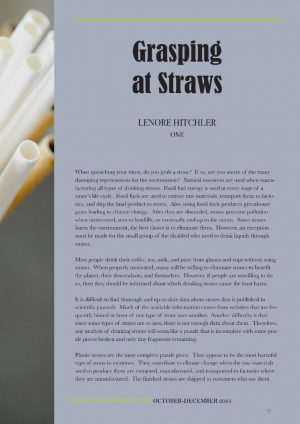 When quenching your thirst, do you grab a straw? If so, are you aware of the many damaging repercussions for the environment? Natural resources are used when manufacturing all types of drinking straws. Fossil fuel energy is used at every stage of a straw’s life cycle. Fossil fuels are used to extract raw materials, transport them to factories, and ship the final product to stores. Also, using fossil fuels produces greenhouse gases leading to climate change. After they are discarded, straws generate pollution when incinerated, sent to landfills, or eventually end up in the ocean. Since straws harm the environment, the best choice is to eliminate them. However, an exception must be made for the small group of the disabled who need to drink liquids through straws.
When quenching your thirst, do you grab a straw? If so, are you aware of the many damaging repercussions for the environment? Natural resources are used when manufacturing all types of drinking straws. Fossil fuel energy is used at every stage of a straw’s life cycle. Fossil fuels are used to extract raw materials, transport them to factories, and ship the final product to stores. Also, using fossil fuels produces greenhouse gases leading to climate change. After they are discarded, straws generate pollution when incinerated, sent to landfills, or eventually end up in the ocean. Since straws harm the environment, the best choice is to eliminate them. However, an exception must be made for the small group of the disabled who need to drink liquids through straws.
Most people drink their coffee, tea, milk, and juice from glasses and cups without using straws. When properly motivated, many will be willing to eliminate straws to benefit the planet, their descendants, and themselves. However, if people are unwilling to do so, then they should be informed about which drinking straws cause the least harm.
It is difficult to find thorough and up-to-date data about straws that is published in scientific journals. Much of the available information comes from websites that are frequently biased in favor of one type of straw over another. Another difficulty is that since some types of straws are so new, there is not enough data about them. Therefore, any analysis of drinking straws will seem like a puzzle that is incomplete with some puzzle pieces broken and only tiny fragments remaining.
Plastic straws are the most complete puzzle piece. They appear to be the most harmful type of straw in existence. They contribute to climate change when the raw materials used to produce them are extracted, manufactured, and transported to factories where they are manufactured. The finished straws are shipped to customers who use them only once before they are discarded. The vast number of discarded straws causes environmental degradation.
The Journal of Cleaner Production published an article about plastic straws. The authors reported that worldwide, one billion plastic straws are used per day. This results in a massive amount of waste. The authors stated “Plastic straws and stirrers contribute 7% to total plastic trash and up to 4% of single-use straws end up in the oceans. … Plastic straws contribute about 1.53 x 105 tons of plastic waste into the environment every year. … The ubiquity, buoyancy, and size of these items (e.g. straws and stirrers) have severe implications for wildlife since they often are mistaken for feed and ingested. The persistence of intact plastics or their fragments (microplastics) in the water bodies is hazardous to aquatic life, also affecting human health, ecosystems, and environmental sustainability.”
When the waste disposal industry processes plastic straws, additional carbon dioxide (CO2) is released leading to climate change. The Department for Environment, Food and Rural Affairs (DEFRA) of the United Kingdom reported that when plastics are incinerated, they release 1,343 kilograms (around 2,960 pounds) of CO2 equivalent per tonne of plastic straws. A large quantity of plastic straws ends up in landfills where they eventually migrate to the seaside. Two Australian researchers, Denise Hardesty and Chris Wilcox, analyzed data from trash collected on US coastlines. They estimated that there are nearly 7.5 million plastic straws on the country’s coasts and 437 million to 8.3 billion plastic straws on the planet’s coasts. Statistics vary on how long it takes for plastic to decompose, but the minimum figure given is several centuries.
A website that sells straws made from sugar cane stated that “exposure to sunlight, salt water, and extreme temperatures can break plastic straws into microplastics.” An article in One Health Advances reported that when microplastics end up in oceans, they absorb sunlight and thus increase the water’s temperature.
Another difficulty with plastic straws is that they contain PFAS. PFAS are poly and perfluoroalkyl compounds that are called “forever chemicals” because they last a long time before decomposing. They are used to make straws water-repellent. PFAS also frequently contaminates the raw materials used for various types of straws. An article in Food Additives & Contaminants reported on the presence of PFAS in 39 brands of straws. They found that 90% of paper straws, 80% of bamboo straws, 75% of plastic straws, and 40% of glass straws contained PFAS, whereas steel straws contained none.
Unfortunately, PFAS are widespread throughout the globe. An article in USA Today reported that according to the United States Environmental Protection Agency (EPA), PFAS are found in food, air, soil, water, and globally in animal and human blood. The EPA found a link between PFAS and the following threats to human health. “Reproductive effects such as decreased fertility or increased high blood pressure in pregnant women. Developmental effects or delays in children, including low birth weight, accelerated puberty, bone variations, or behavioral changes. Increased risk of some cancers, including prostate, kidney, and testicular cancers. Reduced ability of the body’s immune system to fight infections, including reduced vaccine response. Interference with the body’s natural hormones. Increased cholesterol levels and/or risk of obesity.”
Bioplastic straws are another puzzle piece. They were originally considered a better alternative to regular plastic straws. PLA (polylactic acid) straws are manufactured from the sugars found in corn, cassava, beet sugar, and sugar cane. Unfortunately, because of their chemical composition, PLA straws can only be composted in an industrial composting facility. Also, according to an article in Energy Procedia, the carbon footprint of PLA straws is higher than that of plastic straws. Thus, bioplastic straws are not good alternatives to plastic straws. Like bioplastic straws, paper straws are considered a more ecological alternative to plastic straws.
However, paper straws are also bad for the environment. Logging trees for paper contributes to deforestation leading to climate change. When forests are clear-cut, the result is less biodiversity. Fossil fuel energy is used when trees are chopped down and transported to factories where the wood is turned into pulp, and then are formed into straws, and shipped to stores. Additionally, other resources are expended when making paper straws. According to a website that sells straws made from sugar cane, “Paper production uses more water per product than any other industry. It’s the fifth-largest consumer of energy in the world.” Also, paper straws are toxic because water-resistant polymers are added to them so that they do not become soggy and fall apart as soon as they are put in liquids. The PFAS found in paper straws are just as harmful to the environment as the PFAS in plastic straws. Therefore, paper straws cannot be composted because of their toxic plastic ingredients.
All types of straws are packaged in either plastic or paper. This damages the environment during fossil fuel extraction to obtain petroleum products to manufacture plastics or deforestation to provide wood to manufacture paper. When discarded, packaging causes more pollution when it is either incinerated or placed in landfills. Incineration can produce toxic pollution. Methane, an extremely potent greenhouse gas, and CO2 are produced when garbage decomposes in landfills.
Glass straws represent another puzzle piece. They are attractive, recyclable, non-toxic, and dishwasher safe. Some glass straws are shatter-proof. Like other types of straws, the raw materials for glass straws must be extracted, transported to factories, and the finished products shipped to stores. This process also uses energy and thus increases greenhouse gases leading to climate change.
Still another incomplete puzzle piece represents silicone straws. As silicone is a relatively new product, there is not enough data to determine if it is nontoxic to the environment. Silicone is a form of synthetic rubber and is produced by extracting silicon from silica. The silicon is then processed with hydrocarbons to create silicone polymers. Gosili is a company that sells products made of silicone. An article on their website states that silicone lasts an extremely long time, is non-toxic and when made with food-grade silicone is safe, flexible, stain resistant, odorless, hypoallergenic, and dishwasher safe.
Another large puzzle piece represents stainless steel straws. At first glance, steel straws appear to be a good alternative to drinking straws since they can be reused hundreds of times. However, producing them harms the environment. According to an article in the Journal of Environmental Chemical Engineering, the main components of stainless steel are iron, chromium, and nickel. Mining these elements uses large amounts of energy and pollutes the environment. The authors reported that for each plastic straw manufactured, 140 grams [4.93 ounces] of CO2 equivalent are produced. In contrast, for each stainless steel straw manufactured, 520 grams [18.34 ounces] of CO2 equivalent are produced. Statistics regarding the precise amount of energy used to manufacture various straws vary from report to report. However, all studies find that the production of individual steel straws expends more energy and produces more CO2 than the production of plastic straws. A study conducted by the sustainability office, along with an engineering class from California State Polytechnic University, Humboldt, compared the carbon footprint of various types of straws.
The researchers found that manufacturing one stainless steel straw used 0.672 kilowatt hours (kWh) of energy and 217 grams (around 7.65 ounces) of CO2 were released. The figures for one plastic straw were 0.007 kWh of energy and 1.46 grams (around 0.051 ounces) of CO2. The figures for one paper straw were around 0.004 kWh of energy and 1.38 grams (around 4.86 ounces) of CO2. The figures for one glass straw were around 0.306 kWh of energy and 65.2 grams (around 2.29 ounces) of CO2. The figures for one bamboo straw were around 0,209 kWh of energy and 38.8 grams (around 1.368 ounces) of CO2. Unfortunately, plastic straws are only used once before being discarded. In contrast, one individual steel straw can be reused for many years and then can be recycled.
However, the amount of energy used is not the only factor that has to be evaluated when comparing various types of straws. For example, the quantity of raw materials used is also important when evaluating various straws.
An article in the Journal of Cleaner Production compared the amount of raw materials used to produce different types of straws. Starting from the least amount of raw materials used to the most amount of raw materials were straws made from steel, bamboo, glass, plastic, paper, and wheat. Thus, manufacturing steel straws used the least quantity of raw materials. Also, steel drinking straws can be recycled in contrast to plastics, bioplastics, and most paper straws. When recycled, steel drinking straws do not take up space in landfills and energy is not expended during incineration. If recycled, they also do not contribute to soil, air, and water pollution or add harmful toxins to the environment. The puzzle pieces of straws made from agricultural wastes and food crops are the smallest and most incomplete fragments of all the puzzle pieces. These types of straws are so new that scientists have not yet produced much research on them. However, the fertilizers, pesticides, and fossil fuels used to grow, irrigate, and harvest these crops add to pollution and climate change. In addition, the fossil fuel energy used to manufacture and transport them in all stages of their life cycle also produces greenhouse gases that lead to climate change.
Nevertheless, straws produced from agricultural wastes and various crops are less toxic to the environment than plastic straws. Additionally, bamboo and wood straws are reusable and compostable. Avocado, agave, coconut, hay, and sugar cane straws are used once, and can be composted. However, just because they are compostable does not mean that they are composted.
Many people are not able to compost them. For example, most urban residents do not have access to a space where they can compost their organic garbage. This would be especially true for apartment dwellers. 80% of the US population lives in urban areas and globally 56% of the world’s population lives in cities. Worldwide, this adds up to 4.4 billion people who may not be able to compost their garbage. Thus, many plant-based straws will end up being incinerated or put in landfills where the methane that is produced from their decay will increase climate change.
A small puzzle piece represents edible straws. They come in such flavors as lemon, lime, strawberry, and chocolate. Edible straws are not discarded so therefore do not cause additional pollution. A potential puzzle piece represents straws made from hemp. Hemp does not require fertilizers, pesticides, or irrigation, and it grows exceedingly fast. Another puzzle piece represents the brushes used for cleaning reusable straws. The production of them requires the use of natural resources and energy. Also, when they are discarded, if incinerated they produce pollution or else take up space in landfills for many years before they eventually decompose.
Thus, manufacturing drinking straws uses nonrenewable raw materials. In addition, the fossil fuels required for the energy used to manufacture them, transport them, and discard them contribute to pollution including the production of greenhouse gases leading to climate change. Also, when discarded, straws increase soil and water pollution.
Lenore Hitchler





